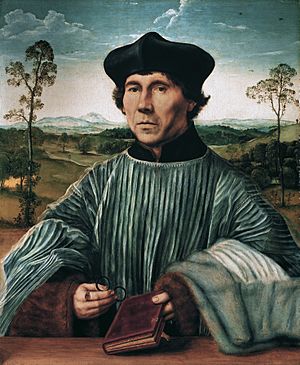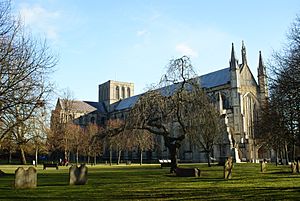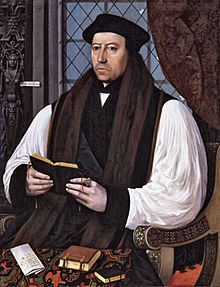Stephen Gardiner facts for kids
Quick facts for kids The Right Reverend Stephen Gardiner |
|
|---|---|
| Bishop of Winchester | |

Portrait by Quentin Matsys
|
|
| Church | Roman Catholic / Church of England |
| Province | Canterbury |
| Diocese | Winchester |
| In Office | 1531–1551, 1553–1555 |
| Other posts | |
| Orders | |
| Consecration | 3 December 1531 |
| Personal details | |
| Born | 27 July 1483 Bury St Edmunds |
| Died | 12 November 1555 (aged 72) |
| Buried | Winchester Cathedral 51°03′38″N 1°18′47″W / 51.06056°N 1.31306°W |
| Nationality | English |
| Denomination | Roman Catholic/Anglican |
| Previous post |
|
| Alma mater | Trinity Hall, Cambridge |
Stephen Gardiner (born 27 July 1483 – died 12 November 1555) was an important English bishop and politician. He lived during a time of big changes in England, known as the English Reformation. He served as Lord Chancellor, a very high position, when Queen Mary I and King Philip ruled.
Contents
Early Life and Education
Stephen Gardiner was born in Bury St Edmunds, England. The exact date of his birth is not fully known. His family made sure he received a good education.
In 1511, when he was about 28, Gardiner met a famous scholar named Erasmus in Paris. Gardiner likely started his studies at Trinity Hall, Cambridge. There, he became very good at studying old languages and writings, especially Greek. He then focused on church law and civil law. He was so skilled in these subjects that no one could argue with his knowledge. He earned his doctor's degree in civil law in 1520 and in church law the next year.
Working for the King
Gardiner's skills soon caught the eye of Cardinal Thomas Wolsey, who was a very powerful figure. Wolsey made Gardiner his secretary. In this role, Gardiner was with Wolsey when an important agreement, the Treaty of the More, was made with French ambassadors. This was probably when King Henry VIII first noticed Gardiner.
Gardiner started working for King Henry VIII a few years later. He learned a lot about how other countries worked while serving Wolsey. In 1527, he helped make a treaty with France to support an army in Italy. As a church lawyer, he was sent to Italy to get permission from Pope Clement VII for King Henry's divorce case to be heard in England. In 1535, he also became an ambassador to France for three years.
The King's Divorce Plans
Gardiner went with Cardinal Wolsey on an important trip to France. King Henry VIII really wanted to be friends with King Francis I of France. He also wanted support for his plan to divorce Catherine of Aragon. Henry asked Wolsey to send Gardiner back for new instructions. But Wolsey said he couldn't spare Gardiner because he was the only one who could help with the king's "Great Matter" – the divorce.
The next year, Wolsey sent Gardiner to Italy to talk to the Pope about the divorce. Gardiner was very good at his job, and his messages show how skilled he was.
Gardiner knew a lot about church law, which was a big help. He was asked to get a special order from the Pope. This order would let Wolsey decide if the king's marriage was valid without anyone being able to appeal the decision. This was an unusual request. Pope Clement VII had recently been held prisoner. He was afraid of upsetting Charles V, Holy Roman Emperor, who was Queen Catherine's nephew. So, the Pope refused to make a final decision about Henry's divorce. Instead, the matter was discussed by his cardinals, and Gardiner had many long talks with them.
Gardiner's arguments did not fully succeed. The Pope did not give the specific order Henry wanted. However, he did give a general permission for Wolsey and another church leader, Cardinal Lorenzo Campeggio, to hear the case in England. Wolsey was thankful for this small step, but he felt it wasn't enough. He urged Gardiner to push the Pope for the special order, even if it was just to be shown to the king and then destroyed. Wolsey worried he would lose the king's trust if he didn't get it. But the Pope did not give in, and Gardiner returned home.
Royal Secretary and Church Views
In August 1529, Gardiner became the king's secretary. He already held several church positions. In November 1531, the king made him the Bishop of Winchester. This was a great honor. The king told Gardiner that even though they had disagreed sometimes, he still valued him.
In 1532, Gardiner upset the king by helping to write a response to complaints against church leaders in the House of Commons. He wrote to the king to defend himself.
In May 1533, Archbishop Thomas Cranmer declared Henry's marriage to Catherine null and void. Gardiner was there to help Cranmer as a lawyer for the king. Soon after, Gardiner went to Marseille for a meeting between the Pope and Francis I. It was at this meeting that Edmund Bonner announced that Henry VIII would appeal to a general council if the Pope ruled against him. Gardiner wrote this appeal.
In 1535, Gardiner and other bishops had to defend the king's new title: "Supreme Head of the Church of England." Gardiner wrote a famous book called De vera obedientia (About True Obedience). It was the best book supporting the idea that the king was the head of the church. Gardiner believed that kings should be obeyed because it was God's command. He thought the king's law was like God's law.
Gardiner was against the Reformation's new ideas about church teachings. He was a leader of those who opposed Archbishop Cranmer. He didn't like how Henry treated the church, especially when Thomas Cromwell was powerful. In 1544, a relative of Gardiner's, German Gardiner, was executed for treason related to the king's supremacy. Gardiner's enemies tried to make the king think Gardiner agreed with his relative.
The king needed both Gardiner and Cranmer. Gardiner wanted to show that England still followed the true faith, even under the king's rule. Cranmer's power as archbishop was needed to support the king's authority. So, Gardiner and Cranmer often disagreed on church policy. Even though Gardiner tried to accuse Cranmer of heresy, the king always protected Cranmer.
New Protestant ideas were becoming popular, especially after the king married Catherine Parr. Queen Catherine herself was almost accused of heresy. Gardiner, with the king's approval, criticized some of her comments.
During Edward VI's Reign

When King Henry VIII died in January 1547, he had planned for a council of 16 men to rule England while his young son, Edward VI, was a child. Gardiner was not included in this council. Edward Seymour, the Queen's brother, took power as Protector Somerset. He and his council brought in many new Protestant changes. Gardiner strongly opposed these changes.
Between Henry VIII's death and the end of 1547, Gardiner wrote at least 25 angry letters. He argued that the reforms were wrong and against the law. Most of these letters were sent to Somerset. Gardiner refused to let church officials visit his diocese (area of church control) in Winchester. Because of his protests, he was put in prison. Even after he was released, he was called before the council. When he refused to answer some questions, he was sent to the Tower of London.
In February 1551, Gardiner was removed from his position as bishop. He stayed in the Tower for the rest of Edward VI's reign, which was two more years. He asked to appear before the House of Lords, but his request was denied. His bishopric was given to John Ponet.
During Mary I's Reign

When Queen Mary I became queen, she freed Gardiner and other important prisoners from the Tower. Gardiner was given back his bishopric and made Lord Chancellor. He placed the crown on Queen Mary's head at her coronation. For a while, he was her main advisor.
Now, in his old age, Gardiner had to undo much of what he had helped create earlier. He had to prove that Queen Mary was born legally and that her mother's marriage was valid. He also had to help bring back the old Catholic religion and take back his own words about the king being the head of the church.
Gardiner was the Lord Chancellor and had the difficult job of arranging Queen Mary's marriage treaty with Philip II of Spain. Many people did not like this marriage. Gardiner made sure the terms of the treaty were as good as possible for England. He made sure the Spanish would not be allowed to interfere in England's government.
Gardiner approved of the law that brought back the heresy laws. He judged Bishop John Hooper and other preachers. He condemned them to be removed from the priesthood. When they refused to return to the Roman Catholic Church, they were handed over to the government to be burned. However, no one in Gardiner's own diocese was executed for heresy until after he died.
In May 1555, Gardiner went to Calais to help make peace with France, but it did not work out. In October 1555, he opened parliament again as Lord Chancellor. But by the end of the month, he became very ill and died.
Death

Bishop Stephen Gardiner died in Westminster on 12 November 1555. His body was later moved to Winchester Cathedral in February 1556. Some people say his last words were, "Like Peter, I have erred, unlike Peter, I have not wept."
Gardiner in Stories and Shows
Stephen Gardiner appears as a character in many plays, books, and TV shows:
- He is an important character in Shakespeare and Fletcher’s play Henry VIII.
- He is a character in The Fifth Queen book series by Ford Madox Ford.
- Gardiner is a major character in The Path to Somerset by Janet Wertman. This book focuses on his rivalry with Edward Seymour, 1st Duke of Somerset.
- He is a key character in Hilary Mantel's books Wolf Hall, Bring Up the Bodies, and The Mirror and the Light. In these books, he is shown as a strong opponent of Thomas Cromwell.
- In the Wolf Hall TV series, Gardiner is played by Mark Gatiss.
- Gardiner is the bad guy in Alison MacLeod's 1965 book The Heretic. This book is about the Protestant martyr Anne Askew.
- In the 1998 movie Elizabeth, Gardiner is played by Terence Rigby. He is shown as a villainous bishop who opposed Elizabeth I's church laws. However, in real life, Gardiner had died before Elizabeth became queen.
- A more accurate picture of Gardiner can be seen in the BBC dramas The Six Wives of Henry VIII and Elizabeth R. In both, he is played by Basil Dignam.
- In The Tudors TV series, Gardiner is played by Simon Ward.
- In the 2022 Starz series Becoming Elizabeth, Bishop Gardiner is played by Alex Macqueen.
See also
 In Spanish: Stephen Gardiner para niños
In Spanish: Stephen Gardiner para niños



